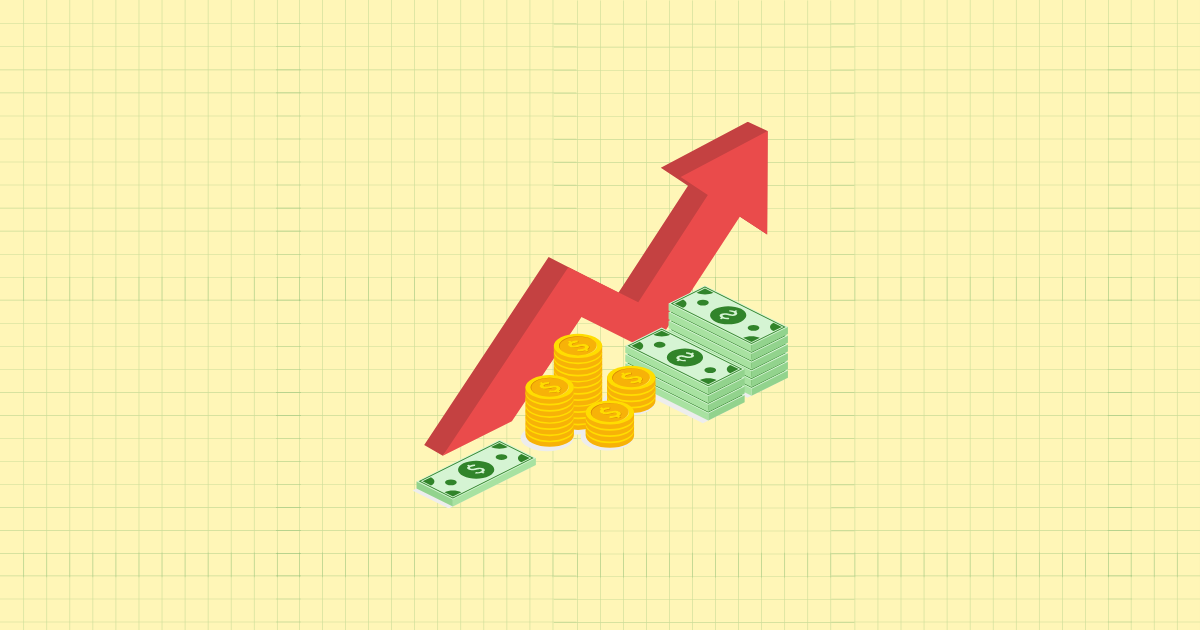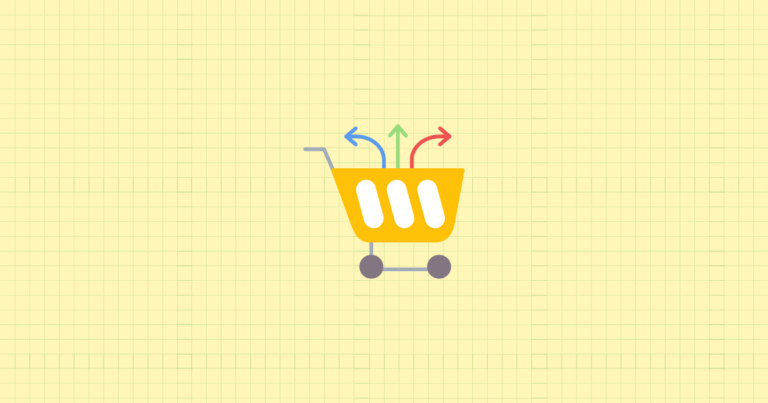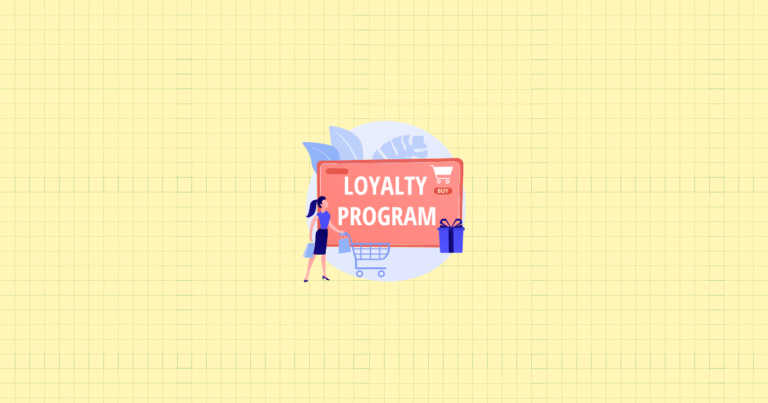Have you ever noticed how a $50 shirt suddenly seems like a bargain when it’s marked down from $100? That’s not an accident—it’s price anchoring in action. And if you’re running a Shopify store, mastering this psychological pricing strategy could be the difference between struggling sales and thriving revenue.
Price anchoring is a cognitive bias where consumers rely heavily on the first piece of pricing information they encounter when making purchasing decisions. For Shopify store owners, it’s a powerful tool that shapes how customers perceive your products’ value—often leading to higher conversion rates and increased average order values.
Why does this matter to you? Because in the increasingly competitive e-commerce landscape, simply having great products isn’t enough. The way you present your prices can dramatically influence buying behavior, sometimes even more than the actual price points themselves.
In this comprehensive guide, we’ll explore how price anchoring works specifically within Shopify’s ecosystem, providing you with actionable strategies to implement this psychological pricing technique effectively and ethically across your store.
Understanding Price Anchoring Psychology
Before diving into implementation, let’s understand the psychological engines driving price anchoring’s effectiveness.

Three key cognitive biases make price anchoring particularly powerful in e-commerce:
The Anchoring Effect
When customers see an initial price (the anchor), it creates a mental reference point that influences all subsequent price evaluations. Research by Nobel Prize-winning psychologists Daniel Kahneman and Amos Tversky demonstrated that once this anchor is set, people tend to make insufficient adjustments away from it—even when they know the anchor shouldn’t influence their decision.
For your Shopify store, this means the first price a customer sees becomes extraordinarily important. It sets the stage for how they’ll perceive every other price on your site.
The Contrast Principle
Our brains naturally evaluate things in relative terms rather than absolute values. When customers see a lower price immediately after seeing a higher one, the contrast magnifies the perceived value of the lower price.
Think about it this way: If you try on a $300 jacket and then a $150 jacket, that $150 option feels like a bargain. If you’d seen only the $150 jacket without the contrast, it might have seemed expensive.
Loss Aversion
People dislike losing something more than they enjoy gaining something of equal value. When you show a crossed-out original price next to a sale price, you’re not just showing a discount—you’re activating loss aversion. Customers feel they might “lose out” on savings if they don’t purchase now.
These psychological principles aren’t just theoretical—they’ve been repeatedly validated in e-commerce contexts. A study published in Quantitative Marketing and Economics found that strategic price anchoring could increase conversion rates by up to 40% in online retail environments. That’s a potential game-changer for your Shopify store.
Implementing Price Anchoring on Shopify
Now for the practical part—how do you actually implement price anchoring on your Shopify store? Fortunately, Shopify offers several built-in features that make this remarkably straightforward.
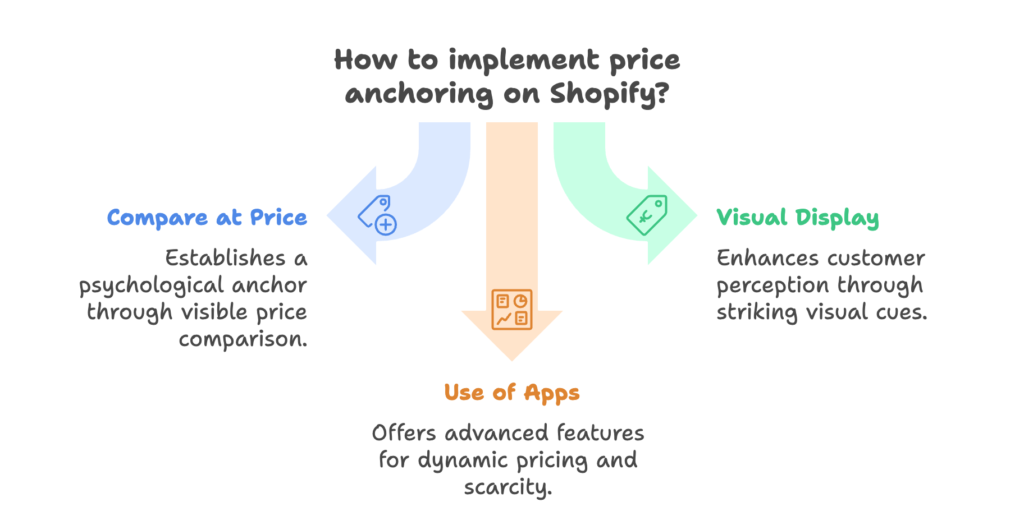
Using Shopify’s “Compare at Price” Feature
The foundation of price anchoring in Shopify is the “Compare at Price” feature. Here’s how to use it effectively:
- Setting up in product details: When editing any product, you’ll find two price fields—the regular price and the “Compare at price” field. The regular price is what customers will pay, while the compare-at price serves as your anchor.
- Bulk editing for efficiency: For stores with many products, use Shopify’s bulk editor to update compare-at prices across multiple items simultaneously. Navigate to Products, select the items you want to update, then click “Edit products” to access bulk editing options.
- Determining the right differential: The gap between your anchor and actual price matters significantly. Too small, and it won’t create enough contrast; too large, and it may seem unbelievable. Research suggests that discounts of 20-25% create the optimal psychological impact while maintaining credibility.
One Shopify store owner I spoke with increased their conversion rate by 32% simply by implementing strategic compare-at prices across their top-selling product categories.
Leveraging Shopify Themes for Visual Price Anchoring
How your prices display visually can dramatically enhance anchoring effects:
- Strike-through pricing: Most Shopify themes automatically display the compare-at price with a strike-through when it’s higher than the actual price. This visual cue powerfully communicates the discount.
- Savings highlights: Many themes can be configured to display either the dollar amount or percentage saved. Test both approaches to see which resonates better with your specific customer base.
- Strategic color psychology: Consider using colors strategically—displaying original prices in red (signaling “stop/caution”) and sale prices in green (signaling “go/positive”) can subconsciously influence perception.
If your theme doesn’t offer these features out of the box, don’t worry. Minor theme customizations can implement these visual anchoring elements without requiring extensive development knowledge.
Integrating with Shopify Apps for Advanced Price Anchoring
For more sophisticated price anchoring, these app categories can extend your capabilities:
- Dynamic pricing apps: These tools allow prices to change based on various factors like customer behavior, inventory levels, or time of day—creating more personalized anchor points.
- Countdown timers: Combine price anchoring with scarcity by showing how long a special price will be available, intensifying the fear of missing out.
- Bundle pricing apps: Create anchors across product combinations, showing the value of bundled items compared to individual purchases.
Remember that the goal isn’t to add complexity but to enhance the customer’s perception of value. Choose apps that complement your overall pricing strategy rather than overshadowing it.
Strategic Approaches to Original Pricing
The effectiveness of your price anchoring fundamentally depends on setting the right original prices. Let’s explore how to determine those crucial anchor points.
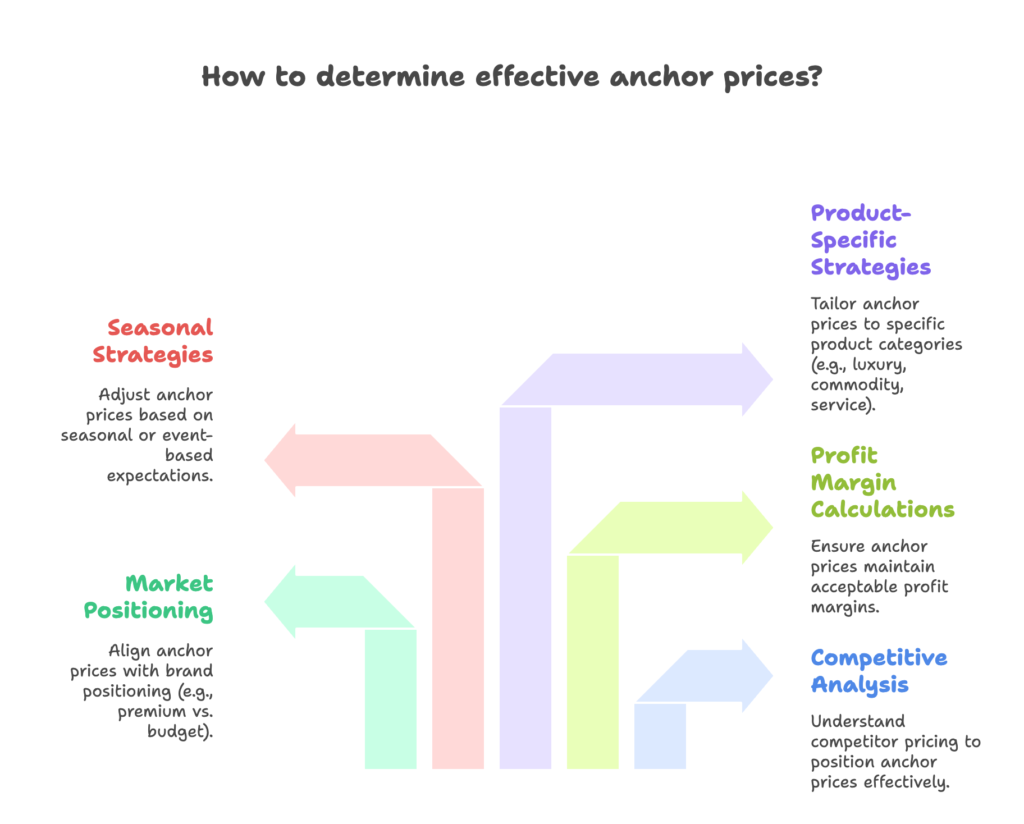
Determining Effective Anchor Prices
Your anchor prices need to be credible while maximizing perceived value. Here’s how to find that sweet spot:
- Competitive analysis: Use tools like Prisync or Competera to understand competitor pricing. Your anchor should be positioned relative to the competitive landscape—neither drastically higher nor suspiciously similar.
- Market positioning consideration: Your price anchors should reflect your brand positioning. Premium brands can establish higher anchors than budget-focused stores, even for similar products.
- Profit margin calculations: Work backward from your minimum acceptable profit margin to ensure that even with anchored discounts, you’re maintaining profitability.
One approach I’ve seen work particularly well for mid-sized Shopify stores is creating a pricing matrix that accounts for both competitive positioning and margin requirements, ensuring anchors are both credible and profitable.
Seasonal and Event-Based Pricing Strategies
Different times call for different anchoring approaches:
- Holiday pricing anchors: During major shopping periods like Black Friday or Christmas, customers expect deeper discounts. Your anchors can be higher to accommodate these expectations while preserving margins.
- Flash sale anchoring: Short-duration sales benefit from more aggressive anchoring to create urgency. A 48-hour flash sale might use a higher anchor point than your standard pricing to emphasize the limited-time value.
- New product launch anchoring: When introducing new products, establishing a higher initial anchor before offering an “introductory price” can set positive price expectations for the product’s lifetime.
The most successful Shopify merchants I’ve worked with plan their anchoring calendar alongside their promotional calendar, ensuring coherent messaging throughout the year.
Product-Specific Anchoring Strategies
Different products require different anchoring approaches:
- Luxury item anchoring: For premium products, anchors should emphasize exclusivity and quality rather than just savings. The anchor serves to reinforce the item’s premium positioning.
- Commodity product anchoring: For everyday items where price sensitivity is higher, direct comparison anchoring (showing your price versus a common market price) can be highly effective.
- Service-based anchoring: For Shopify stores selling services, anchoring based on time-savings or outcome value rather than just price can create more compelling value propositions.
The key is aligning your anchoring strategy with customer expectations for each product category. What works for luxury accessories won’t necessarily work for everyday essentials.
Creating Effective Discounts with Price Anchoring
Now let’s connect price anchoring specifically to your discount strategy, creating a powerful combination to drive conversions.
Types of Discounts Compatible with Anchoring
Different discount types trigger different psychological responses when combined with anchors:
- Percentage-off discounts: These work well when the percentage seems substantial (20% and above). They’re particularly effective for higher-priced items where the savings amount becomes impressive.
- Dollar amount discounts: For lower-priced items, concrete dollar savings (“Save $15”) often feel more tangible than percentages and create stronger anchoring effects.
- Buy-one-get-one offers: BOGO deals create a powerful implicit anchor—the value of getting something “free” is psychologically anchored against the paid item’s price.
A fascinating pattern I’ve observed across successful Shopify stores is that percentage discounts typically outperform for items over $100, while specific dollar amounts often work better for items under that threshold.
Using Shopify’s Discount Features with Anchoring
Shopify offers several ways to implement anchored discounts:
- Automatic discounts: Create store-wide or collection-specific discounts that automatically apply at checkout, while maintaining your anchor prices throughout the shopping experience.
- Discount codes: Strategic codes combined with anchored pricing create a “double-discount” psychological effect—customers feel they’re getting an exceptional deal when they can apply a code on top of an already “discounted” price.
- Script Editor (Shopify Plus): For advanced merchants, Script Editor allows complex discount rules that can dynamically adjust based on cart contents while maintaining your chosen anchor points.
The most sophisticated approach I’ve seen combines all three—using anchored pricing consistently, applying automatic discounts for certain thresholds, and offering exclusive codes for email subscribers or loyal customers.
Timing and Duration of Anchored Discounts
The temporal aspect of your discounts significantly impacts their effectiveness:
- Limited-time offers: Shorter durations create urgency. When combined with clear anchoring, 24-72 hour sales typically generate the highest conversion rates.
- Graduated discounts: Starting with a smaller discount that increases over time creates multiple anchor points and can keep customers engaged throughout a longer promotion.
- Personalized timing: Tailoring discount timing based on customer behavior (like cart abandonment or browsing patterns) can make anchored discounts feel more relevant and compelling.
One particularly effective strategy I’ve witnessed is what I call “anchor shifting”—where the anchor price remains constant, but the actual price changes at scheduled intervals, creating both urgency and a sense of special opportunity.
Measuring and Optimizing Price Anchoring Effectiveness
Like any strategic approach, price anchoring requires continuous measurement and refinement.
Key Metrics to Track in Shopify Analytics
Focus on these metrics to understand anchoring effectiveness:
- Conversion rates: Track changes in conversion rates when you implement or modify anchoring strategies. Look at both overall store conversion and product-specific conversion.
- Average order value: Effective anchoring often leads to higher AOV as customers’ price sensitivity decreases.
- Product page bounce rates: High bounce rates on pages with anchored pricing may indicate that your anchors lack credibility or relevance.
Shopify’s native analytics provide these basics, but consider enhanced analytics apps for deeper insights into how customers interact with your anchored pricing.
A/B Testing Price Anchoring Strategies
Systematic testing is crucial for optimization:
- Setting up basic tests: Use Shopify’s native features to test different anchor points on similar products, or test the same product with different anchor approaches across time periods.
- Advanced testing apps: Tools like Google Optimize or dedicated Shopify A/B testing apps allow more sophisticated experiments with statistical validation.
- Interpreting results: Look beyond immediate conversion impacts to consider long-term effects like return rates, customer lifetime value, and brand perception.
I recommend starting with straightforward A/B tests—perhaps comparing a 20% discount from a higher anchor against a 15% discount from a slightly lower anchor—and gradually increasing complexity as you gather more data.
Customer Feedback and Perception
Quantitative metrics tell only part of the story:
- Post-purchase surveys: Simple questions about price perception and value can reveal how effectively your anchoring strategy is shaping customer perception.
- Review analysis: Monitor product reviews for mentions of value, pricing, or deals—these provide qualitative insights into anchoring effectiveness.
- Support inquiries: An increase in pricing questions may indicate that your anchoring strategy is causing confusion rather than clarity.
The strongest anchoring strategies create a consistent narrative that customers internalize and even reference themselves. When you see customers mentioning “I got this at a great discount from the original price” in reviews, you know your anchoring is working deeply.
Ethical Considerations and Best Practices
Effective price anchoring must be built on a foundation of ethical business practices and customer trust.
Maintaining Pricing Integrity and Customer Trust
Price anchoring is a powerful tool that demands responsible use:
- Authentic reference prices: Your anchor prices should represent genuine value points, not artificially inflated figures. The most sustainable approach is using anchors that reflect either previous selling prices or legitimate market alternatives.
- Legal compliance awareness: Different regions have varying regulations regarding reference pricing. For instance, in the UK, products must have been sold at the higher price for a specific period before it can be used as a reference price for discounts.
Remember that while short-term gains might come from aggressive anchoring, long-term success depends on customer trust. When customers feel misled by your pricing practices, the damage to your brand can far outweigh any temporary conversion boost.
Balancing Profitability with Customer Value
The most successful price anchoring strategies create genuine win-win scenarios:
- Relationship-focused pricing: Consider lifetime customer value rather than maximizing each transaction. Sometimes a smaller margin with stronger perceived value builds more loyalty.
- Brand consistency: Your anchoring strategy should align with your overall brand positioning. Premium brands can undermine their positioning with too-frequent or too-steep discounts from anchor prices.
I’ve watched Shopify stores destroy years of premium positioning with overly aggressive anchoring tactics that trained customers to never pay full price. The most successful stores use anchoring as one tool in a balanced pricing strategy, not as a constant crutch.
Adapting Price Anchoring for Different Product Types
One size doesn’t fit all when it comes to anchoring strategies:
- High-ticket vs. low-cost approaches: For expensive items, emphasize value components and quality differences that justify the anchor. For low-cost items, focus more on immediate savings and deal perception.
- Subscription-based products: For recurring revenue models, anchoring can focus on lifetime value comparisons or tiered pricing structures that make your preferred subscription level seem like the obvious value choice.
The most sophisticated Shopify stores I’ve consulted with segment their anchoring strategies by product category, customer type, and even by acquisition channel, recognizing that different contexts demand different approaches.
Conclusion: Maximizing Shopify Success with Strategic Price Anchoring
Price anchoring isn’t just a tactic—it’s a fundamental psychological principle that shapes how customers perceive value in your Shopify store. When implemented thoughtfully, it creates a win-win: customers feel they’re getting great value, and you achieve stronger sales performance.
Remember these key principles as you develop your strategy:
- Anchor prices establish the reference point for value perception
- Visual presentation enhances anchoring effects
- Different products and seasons require tailored anchoring approaches
- Testing and measurement reveal what works for your specific audience
- Ethical implementation builds sustainable customer relationships
Start by implementing basic compare-at pricing on your top-selling products, measure the results, and gradually expand to more sophisticated approaches as you gather data on what resonates with your customers.
The e-commerce landscape continues to evolve, but the psychological principles behind price anchoring remain remarkably consistent. By mastering these principles now, you’re building a foundation for pricing success that will serve your Shopify store for years to come.
References
- Kahneman, D., & Tversky, A. (1974). Judgment under Uncertainty: Heuristics and Biases. Science, 185(4157), 1124-1131. https://www.jstor.org/stable/1738360
- Shopify. (2025). Setting sale prices for products. Shopify Help Center. https://help.shopify.com/en/manual/products/details/product-pricing/sale-pricing
- Anderson, E. T., & Simester, D. I. (2003). Effects of $9 Price Endings on Retail Sales: Evidence from Field Experiments. Quantitative Marketing and Economics, 1, 93-110. https://doi.org/10.1023/A:1023581927405
- Competera. (2025). Price Anchoring Strategy: How It Shapes Customer Perception. Competera Blog. https://competera.ai/resources/articles/price-anchoring-strategy
- HubSpot. (2023). Price Anchoring: How to Tailor Prices to Play on Consumers’ Biases. HubSpot Blog. https://blog.hubspot.com/ecommerce/setting-ecommerce-prices-psychology-sales
- Shopify. (2025). Shopify API Documentation: Price Rules. Shopify Developers. https://shopify.dev/api/admin-rest/2023-01/resources/price-rule
Ready to supercharge your Shopify store’s sales with perfectly optimized discount codes? Growth Suite is a Shopify app that helps you run effective on-site discount and email collection campaigns. With its powerful data analysis engine, Growth Suite tracks visitor behavior and generates personalized, time-limited discount codes that maximize conversions. Install it with a single click and start seeing results immediately!
Don’t forget to check these articles;

